Death on the Ring: What Happens When the Nürburgring Loses One of Its Own


On October 4, 2021, Nikola Koprivica, 34, was killed in a crash in his Mazda MX-5 during a public Touristenfahrten (“tourist drive”) session on the Nürburgring Nordschleife. According to the local Adenau Polizei, Koprivica hit a truck attending to a disabled vehicle that had spilled fluid on the track near the Bergwerk corner. An additional 10 vehicles had to take evasive action, and some hit Koprivica's MX-5 after he'd hit the truck. Koprivica died on the spot; seven others were taken to the hospital, two with serious injuries. According to Koprivica's wife, Kristina, an investigation into the accident is ongoing.
Koprivica was part of a thriving community of locals and expats that has sprung up in the villages that the infamous Nürburgring Nordschleife circuit loops around in its quiet corner of Germany. They form a cottage industry of mechanics, like Koprivica, as well as former racers-turned-driving-instructors who sit right seat or offer hot laps in Ring “taxis,” people who offer car rentals and track rides—even the owners of the hotels, restaurants, tire shops, gas stations, repair garages, and souvenir shops. They make a living through these informal networks. The more established expats help new arrivals (particularly those who don’t speak German) to handle local bureaucracy, to find a place to stay, a place to work. They operate in something like the world’s fastest ski town; except the mountain is a racetrack.
After the death of Koprivica, the Ring Bums have reason to be scared.
Koprivica’s fatal crash has left many Ring regulars and local business operators wondering if the track has become too dangerous. It also leaves the community in a precarious spot. Road & Track spoke about safety conditions with a number of people whose livelihood depends on the Ring. Many wished to remain anonymous for fear of reprisal from circuit management, which controls access to the track. Everyone we spoke to wants change, but many fear the consequences of speaking out publicly. The Ring is the only game in town. No one wants to get shut out.

The Nürburgring is a racetrack only when it wants to be: during actual races, private track days, and auto-industry testing days. When it comes to Touristenfahrten sessions, the Nürburgring's famous Nordschleife—the Northern Loop, a 12.94-mile behemoth with 73 corners—is technically considered a privately owned toll road that falls under German traffic laws. The Nürburgring declined to provide figures on how many drivers participate in TF sessions per day, though Marc Müller, who operates Rent4Ring, a company that provides rental cars for TF participants, estimates that on a weekday, you might see 50-200 individual cars pass through the toll gate in a session. On a weekend, it could be 500-1000. The busiest weekends may see around 2000, with up to 250 cars on track at any given time.
It’s hard to say exactly how dangerous the Ring is, statistically speaking. The Adenau Polizei provided Road & Track with data on incidents at the Nürburgring, including both the Nordschleife and the Grand Prix circuit, which is only used for private events. In 2018, the Polizei were made aware of 90 accidents, with one fatality, 15 serious injuries, and 18 minor injuries; in 2019, 84 accidents were reported, with 18 serious injuries, 15 minor injuries, and no fatalities; 2020 had 67 reported accidents, with one fatality, 10 serious injuries, and 11 minor injuries; in 2021, there were 76 reported accidents, with one fatality, 28 serious injuries, and 13 minor injuries. Earlier in June, a motorcyclist was killed after a crash during a TF session. A spokesperson for the Adenau Polizei noted that authorities are not made aware of every accident at the track. "Especially the accidents with only property damage are not always brought to our attention," the spokesperson said.
"Everyone says, 'It's not a racetrack, it's a toll road,'" one source who requested anonymity told R&T. "You kind of have to say that, otherwise the government might say, 'You can't run a racetrack and let everyone on it.'" The Nürburgring itself says the track is a "one-way street" and that when it's not being used for private testing and racing, it's subject to German road traffic regulations. Martin Fehrmann, a frequent Touristenfahrten driver, had his Corvette totaled in the early stages of the multi-car crash, moments before it collected Koprivica.
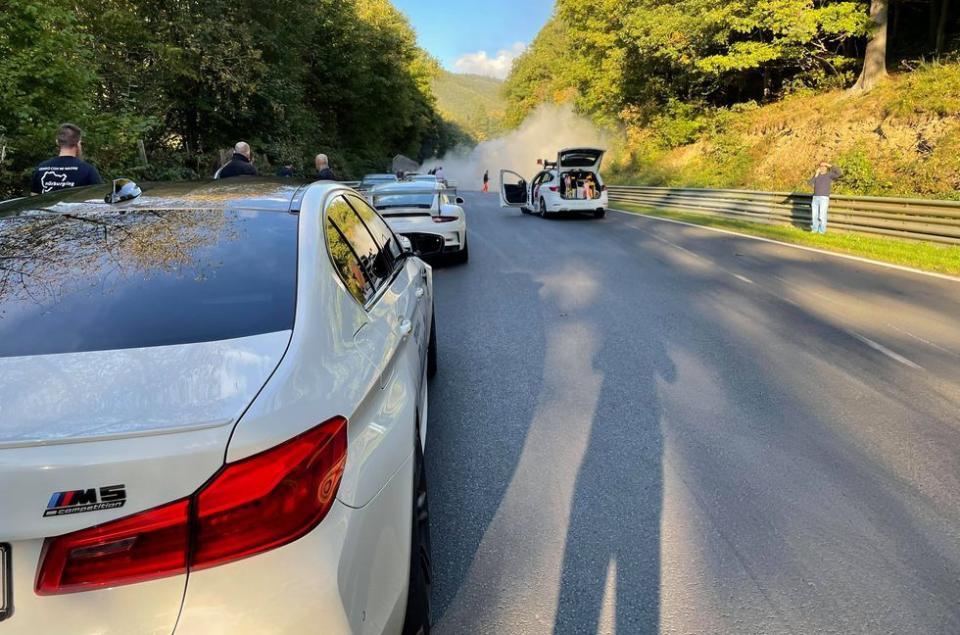
“I had the great luck of being at the scene of the accident before Niko's fatal accident,” Fehrmann told Road & Track via Facebook message. “I can only report the following.”
“When turning into the Lauda links, I slid with the Corvette, through the [downed fluid], completely to the right in the direction of the crash barrier. On the way I was able to steer to the left again. Unfortunately, the tow truck was 50 percent across the right side of the track.”
Fehrmann says he then was caught in a three-car pileup involving two Porsches some 100 feet past the tow truck itself, only to watch the crash that killed his friend unfold.
“Left in front of me (right next to the tow truck) was a Porsche that I drove into. A few seconds later another Porsche hit me. The three of us then stood about 30 meters further from the tow truck in the direction of Bergwerk. Just as I got out, the actual mass crash at the tow truck (back in the direction of the Lauda curve) took place.
“In this mass crash, the remaining 10 vehicles and motorcycles crashed into each other within a few seconds.”
Niko’s death was not easy on Fehrmann; they were part of the same tight-knit world.
“I’d known Niko for years. We often saw each other at the Ring, always said hello. Even 30 seconds (!) before the accident, I overtook Niko and we waved.
“I still couldn't sleep at night more than two weeks after the accident and cried the whole time because I was so shaken.”
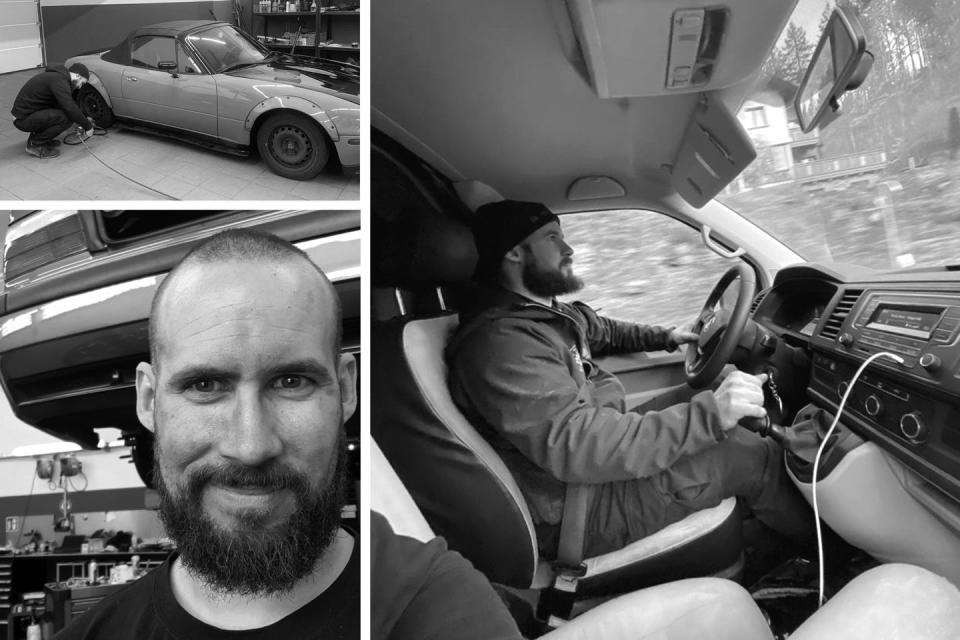
Enthusiasts from all around come to the Nordschleife, just as the Croatian Koprivica did with his Mazda MX-5. Konstantinos Zannos, a driving instructor who splits time between Belgium's Spa and the Nürburgring, was a good friend of Koprivica. Zannos told R&T that he and Niko got to know each other working with track-day support company RSR Nürburg at Spa. After some time in Belgium, Koprivica decided to head to the Ring in 2019, finding employment with Custom Racetec, a company that builds and maintains cars specifically for Nordschleife duty. He preferred Germany to Belgium, and spoke German well, so the move was an obvious choice. On the day of his fatal accident, Koprivica was on a brief vacation, set to start a new job with the legendary Ring-based Porsche shop Manthey-Racing.
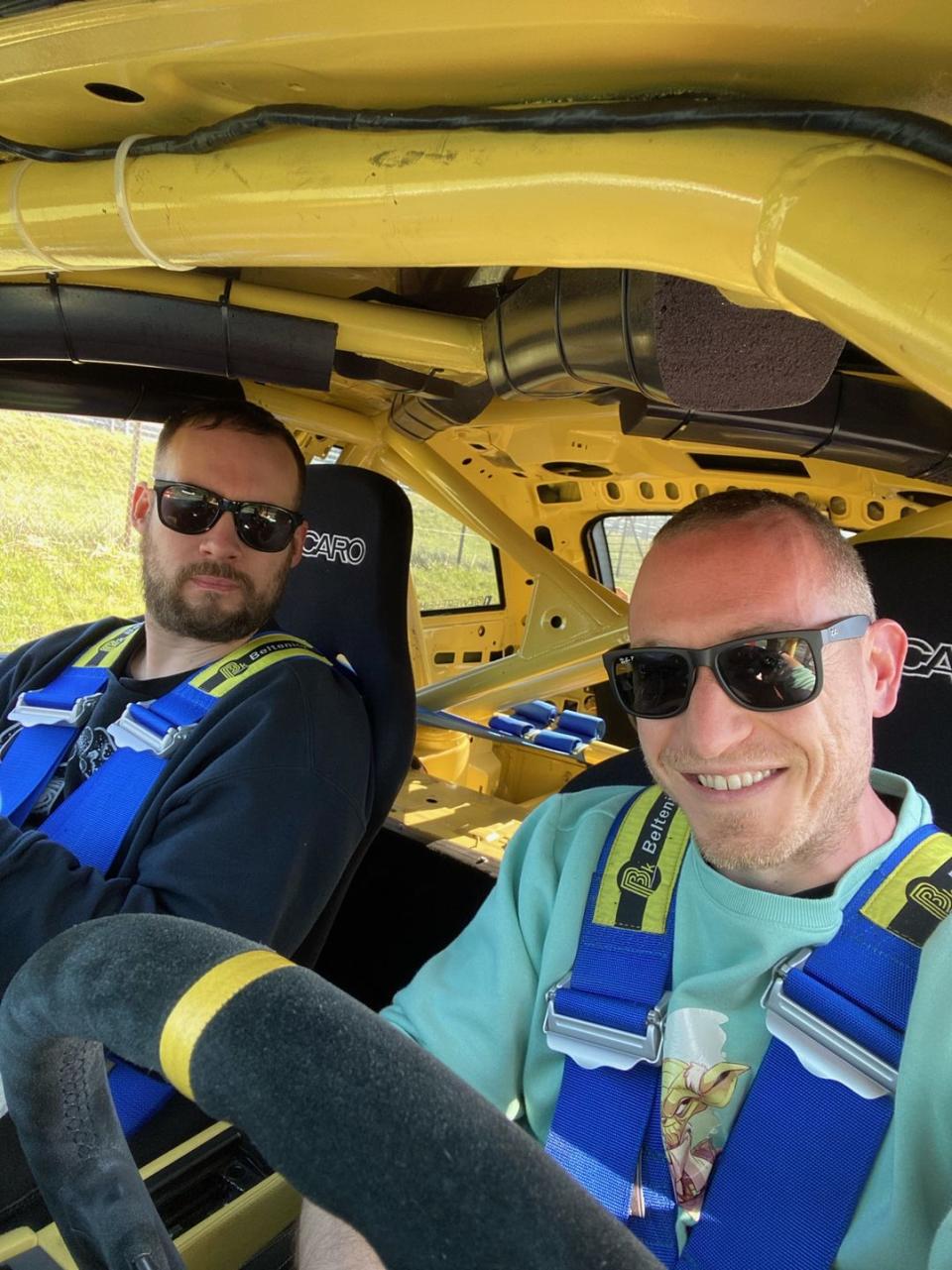
Koprivica was part of a support industry for those making a pilgrimage to drive this track in real life and not only on their PlayStation. It's a healthy business of Ring tourism—feeding them, training them, renting and repairing cars they drive. And it is the business there, the moneymaker. Not much else happens in the Eifel mountains. Nobody wants to see the Ring threatened, nobody wants it shut down. But the people who depend on it do want it safer.
"When I'm there to make my living out of it, I want to believe there are some fundamental rules that are being followed," said Zannos. He was one of the first—and few—to speak out publicly seeking change at the track after Koprivica’s death.
"When I go there to drive or to coach, I know that I'm taking a risk,” Zannos said. “When I say to my wife that I’ll be back safe, I want it to be as reassuring as possible for her."
TF sessions are an almost complete free-for-all, though there are cardinal rules: Lap timing is prohibited; speed limits are posted in a handful of places around the track. You’re supposed to pass on the left, and only after the vehicle ahead moves to the right, and drifting is not allowed. Helmets are only required for motorcyclists, and head restraints or HANS devices are prohibited, as, according to a Nürburgring spokesperson, they are "not compatible with road traffic regulations." Essentially, anyone with an insured road-legal vehicle and a license can turn up at the gate, pay the toll, and run a lap. (Many YouTube videos show drivers flouting that first rule of no lap timing. A Nürburgring spokesperson told us that "on repeated cases and depending on the professionalism and range of the channel, house bans may be imposed" for YouTubers posting lap times. At the time of writing, at least 12 videos disregarding this rule had been uploaded to YouTube just in the past week.)
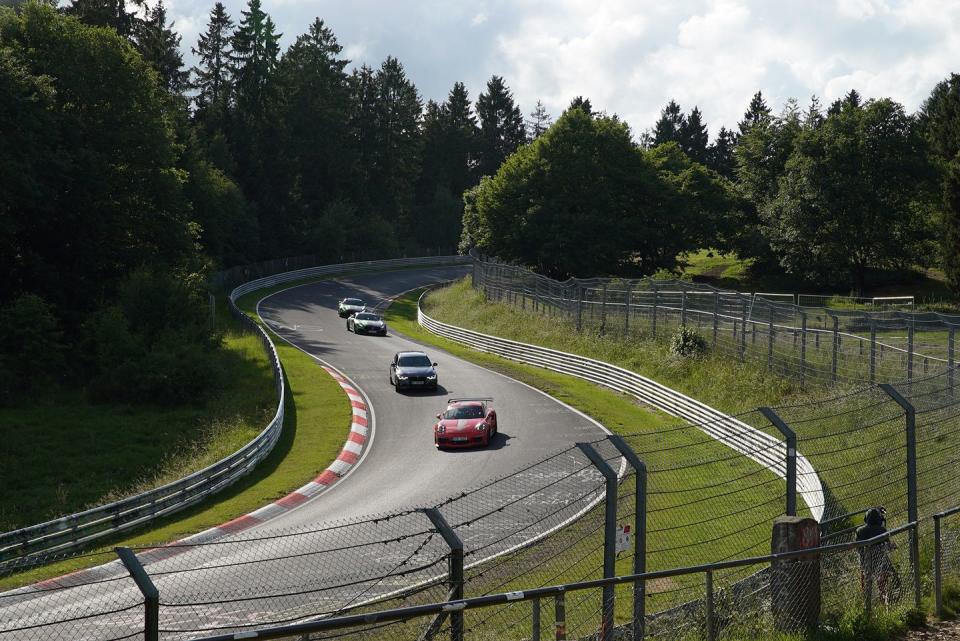
It was during one of these sessions that Koprivica was killed. Fehrmann told Road & Track that Koprivica’s crash occurred around 165 feet before Bergwerk and just after the Lauda corner—named for the late F1 champ Niki Lauda, whose fiery 1976 crash occurred here—and he saw no marshals waving yellow flags, and a light installed at the preceding Breidscheid was not lit. Fehrmann told us there was no safety vehicle escorting the recovery truck.
Other drivers familiar with the events of October 4 said there were very few safety marshals on hand for that day’s tourist session. That’s a typical scenario—a Nürburgring spokesperson told R&T that it has around four-six "moving marshals" with safety cars on Monday-Thursday, and on weekends and holidays, it has 20 marshals and an additional eight-10 moving marshals. (The crash occurred on a Monday.) In contrast, ADAC Nordrhein, which operates the Nürburgring 24 Hours race, the biggest Ring event of the year, confirmed to Road & Track that it hires 1000 marshals for the race weekend. While 125 marshals are deployed in the paddock and on pit lane, the rest are scattered around the track, working in shifts. The N24 utilizes a combined layout of the Nordschleife and Grand Prix track, and while an ADAC Nordrhein spokesperson says it's impossible to say how many marshals are around the track at any given time, they pointed out that the combined circuit has 207 trackside marshal posts, 147 of which are on the Nordschleife. At most major races, you'll likely see at least one worker per marshal post, so there are eyes on all parts of the track. Even with 20 permanently stationed marshals and 10 moving marshals, it would be impossible to monitor all 12.94 miles of the Nürburgring.
There was an element of terrible luck here. "You could not pick a worse place to put coolant and a worse place to have the truck passing by," an instructor source noted. Plus, global events on October 4 hampered the improvised safety communications system put in place by Ring regulars. On that day, Facebook went down worldwide.
About five years ago, Ring regular Sam Neumann and some colleagues started a WhatsApp group called TrackSecure as a way for drivers to stay updated on conditions around the track. Since then, Neumann, partner Tillman Glaser, and a small team have developed TrackSecure into a standalone smartphone app. Drivers and marshals can report incidents or dangerous conditions via a simple interface, and those updates are broadcast to everyone else running the app nearby. It's designed to work on any racetrack in the world, with or without cell signal, and it's not reliant on Facebook.
The ad-hoc driver safety system was launched out of tragedy some five years ago. "If I remember correctly, it all started with another awful crash," Glaser said. "Very similar to the one [on October 4], with seven or even more cars crashing. I don't know if there was somebody who passed away, but it was an awful crash, and so Sam and some colleagues thought, 'We need to do something to ensure more safety.' Which additionally shows that in those five years, nothing has really improved from the Ring side."
TrackSecure remains popular on WhatsApp, with over 5000 members split across over 20 groups. WhatsApp is owned by Facebook; when the social media juggernaut experienced a complete service outage on October 4, the messaging app went down too. It’s unclear what impact this had on the events at the Ring that day; one source said the accident happened so quickly, the WhatsApp group probably wouldn't have been able to alert Koprivica in time, were he using the app. But the mere fact that a number of Ring drivers find themselves relying on a third-party app or a group chat for crucial safety updates speaks volumes. "The problem always was, and is now, the amount of marshals there during the week," Neumann said. "I'd guess there are sometimes only five people, and five people can never see everything over 20 kilometers."
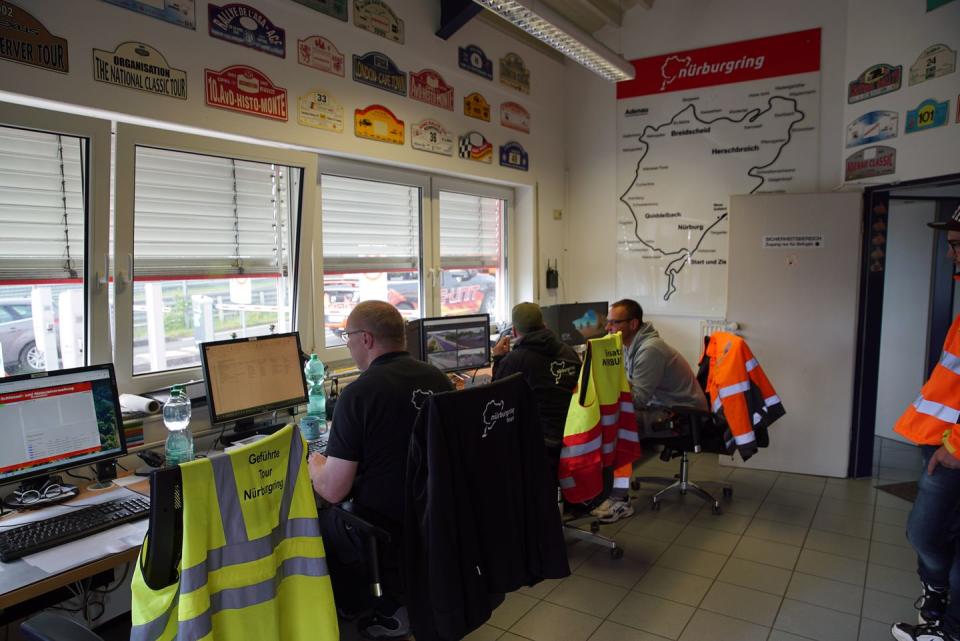
For its part, the Nürburgring is putting significant resources into an AI marshaling system, with test cameras set up along the Dottinger Hohe straight, though that’s the part of the track with the best visibility, meaning the safety system is less crucial in that spot. Many also pointed out the lack of warning lights around the track. At many major racetracks, a series of lights are placed around the circuit. A flashing yellow or red light tells drivers to slow down and watch for danger ahead. But on the Nordschleife, there are just 13 lights for the entire track.
A Nürburgring spokesperson told Road & Track that in response to Koprivica's death, the track is accelerating its trials of a "digitization" process. The ongoing pilot program consists of smart cameras and AI software that can automatically trigger LED warning lights when it notices spilled coolant or oil on the track or when a vehicle goes off course. If and when the AI marshaling system is implemented around the full Nordschleife following its pilot, the Nürburgring expects to have over 100 cameras set up around the track and likely an upgraded race control center to monitor the new system. It’s unclear when those safety upgrades might be put into place. A Nürburgring spokesperson said that due to the lack of trackside electricity and other wiring infrastructure, the implementation of this new technology throughout the whole forest-surrounded track is a massive undertaking.
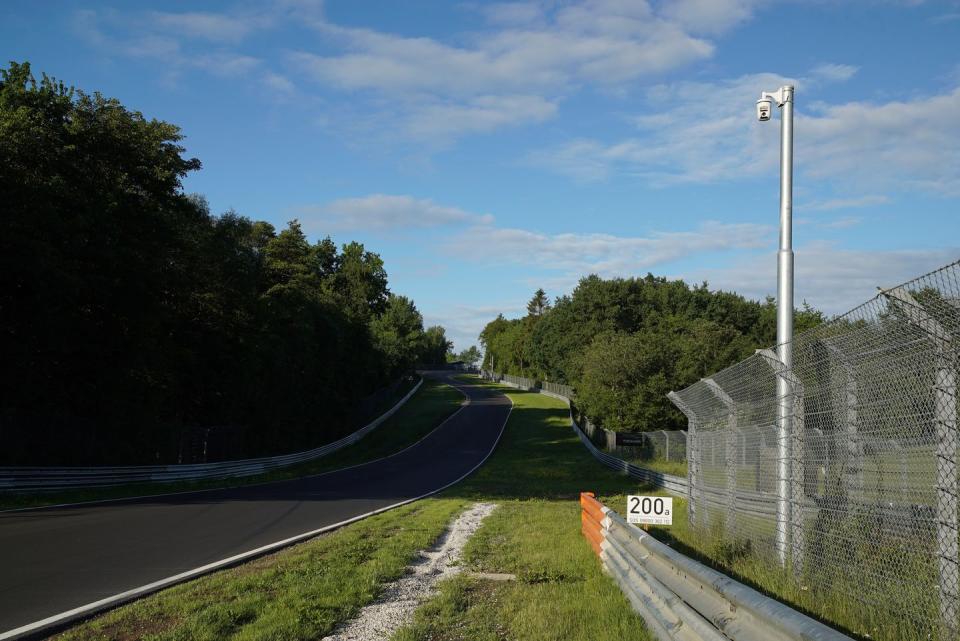
The Ring also gave no timeframe for when it would add to the 13 traffic lights on the track, only saying that they "could" be upgraded. Prominent Nürburgring-based YouTubers Misha Charoudin and Robert Mitchell—the owner of car-rental provider Apex Nürburg—notably spoke out publicly after Koprivica's death, calling for the implementation of the sort of system the track is now trialing. To our knowledge, no other racetrack in the world is testing such a system. Typically, track-day organizers hire human marshals to stand at stations positioned around the track with flags to communicate any issues with drivers.
Glaser said he communicated with Ring management following the October 4 accident. It wasn’t the first time: Two years ago, the developers of TrackSecure spoke with Ring organizers to discuss an official partnership, but those talks broke down.
"After [Koprivica's] crash, we wrote an email to them and said, 'Okay, this shocking crash might be the initiator to talk to each other again. Whatever that means, we could sit at a table together. We should talk,'" Glaser said. "We even told them that there are journalists who are asking us about that crash. But all they wrote back was something like, 'We need to do a root cause analysis of that crash on our own. And you know, we are investing lots of money into safety and we don't know how we will continue. So right now we don't necessarily see the need to talk to you.' That's a Hollywood no," Glaser said.
The Ring says that it attempts to learn from the crashes that occur on the track in an effort to improve safety "We need to [analyze the crashes],” Nürburgring spokesman Alexander Gerhard said. “It's our job. Of course. When there's some tragic accident, the police come anyway, they analyze how it happened. Of course, this is something for when we look at how to increase safety. But we don't have as many accidents as you might think." Gerhard said there’s one recorded incident (anything from spilled fluids to a crash) on the track for around every 809 laps driven.
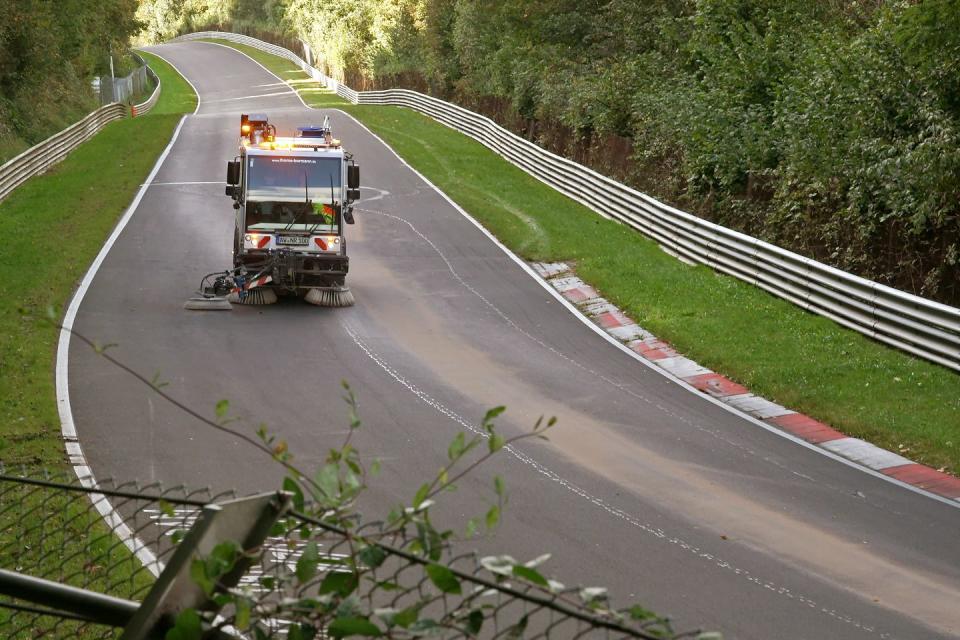
Nobody has a clear answer on what should be done in the wake of Koprivica’s fatal crash. But everyone we spoke with agreed something needs to change. It would seem there’s a financial incentive to keep customers safe. Fehrmann simply wants more marshals.
Those who make a living at the Ring want the track to become a safer place to drive—without jeopardizing their livelihoods. Achieving that will require a delicate balance. Many believe it’s a challenge worth pursuing.
"What I would like is for Niko's incident to not go in vain," Zannos said. "If something good can come out of it, I think that's what he would like. So that's what I would like."
Additional reporting by Aaron Brown.
You Might Also Like

